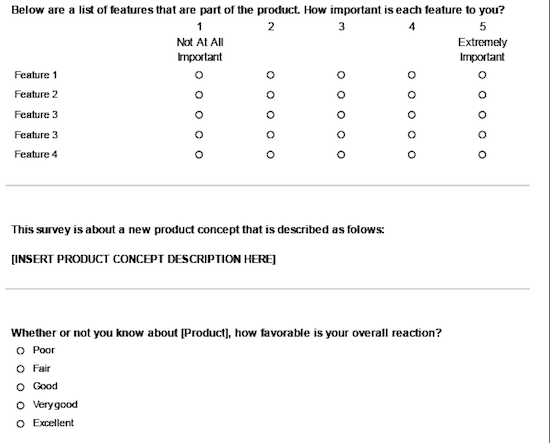
Have you been thinking about an idea for a new product? Have you tested it to see how it will be received in the marketplace?
In this article I’ll help demystify concept testing and show you how even on the leanest of budgets, you can rest assured that you know what you need to know to take your concept to the next stage.
#1: Familiarize Yourself with Concept Testing
Kotler and Armstrong suggest that concept testing is one of eight major stages in product development that follows the idea generation and screening phases. And involves “drafting the product idea in verbal or pictorial form, further explaining the nature of the concept, with initial ideas of impediments, materials and technologies. New product concepts are tested with a group of target consumers to find out if the concepts have strong consumer appeal. “
Concept testing may be one of the most important steps you’ll take a long the way and to do it effectively you should have some specific goals in mind.
#2: Create Obtainable Concept Testing Goals
Whether your business is large or small, the goals of concept testing are the same–to conduct the test among the widest segment of the appropriate population. Fortunately these days social networks provide an easy and cost-effective solution for targeting and segmenting potential audiences.
Jakub Hrabovsky recommends looking at demographics that focus on:
- Characteristics of the customer; age, gender, income bracket, education, job, and cultural background, lifestyle, such as social class, lifestyle, personality, opinions, and attitudes.
- Specific customer behaviors e.g. online shoppers, shopping center customers, brand preference and prior purchases.
- Geographical location such as continent, country, state, province, city or rural that the customer group resides.
#3: Take the Necessary Steps to Prepare for a Concept Test
An integral part of the preparation stage is being able to identify characteristics of your ideal customers and solutions they might be looking for.
Karl Stark and Bill Stewart offer a list of insightful questions that will be helpful to consider before moving forward:
- Who are the ideal customers?
- Does the product already exist?
- What is the customer doing currently?
- What is the all-in cost of the current solution?
- What asset or capability are you bringing that is unique?
- How will competitors react to a successful launch?
- What is the business model?
- How can you test and learn before building the entire structure?
If you’re ready, carve out some time and write down your responses to these questions and you’ll be well on your way to taking the next step, designing a survey.
#4: Consider 10 Factors for Survey Design
The design phase is very important. After all, once you have gained your participants’ attention you’ll want to make sure that you’ve thought through a number of factors so that people will stick-in and complete the survey.
(Sources: Qualtrics, Lightspeed Research)
- Describe the concept in a clear and understandable way and include product benefits.
- Familiarize yourself with the variety of question types and determine the best formats to use e.g. multiple choice, fill-in-the-blank, open ended, rank order, and questions in matrix tables.
- Identify distribution channels for ways to best engage participants: email website, blog or QR codes; mobile compatible surveys; social network integrated—Facebook, Twitter, Linked-In.
- Estimate how much time it will take for participants to complete the survey. The number of questions may vary from one survey to the next.
- Keep online questionnaire length under 20 minutes.
- Evaluate each questionnaire to eliminate “nice to know” questions (i.e. questions that don’t directly relate to the objectives and success criteria).
- Keep the number of questions asked prior to concept exposure to a minimum.
- Think about questions from the respondent’s point of view – if you were a respondent would you want to answer? For example: Use technology to make questionnaires more respondent friendly (e.g. to skip questions that don’t apply).
- Watch out for repetitious questions. You may think you are asking different questions (e.g. product is healthy and product is good for you), but respondents often don’t see it that way.
- Consider using split questionnaire designs to break a long questionnaire into manageable tasks. The second questionnaire is fielded to those returning the first questionnaire. This makes the task a little less daunting for respondents while still gathering all the information from the same respondents.
#5: Design Your Concept Test Without Reinventing the Wheel
It’s always good to know that there are some ready-to-use online resources. We came across several templates that will help to get you started with concept testing without having to reinvent the wheel.
Here are four that will help you get started in no time:
Brief Product Concept Test from Question Pro

Product and Concept Testing Survey from Survey Onics

Concept Evaluation and Pricing from QuestionPro

Sample Concept Test Survey from Qualtrics

The importance and thoroughness of concept testing cannot be emphasized enough. Your ideas deserve the best shot in the marketplace; take the necessary time and steps to make your business a success.